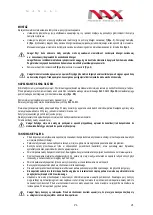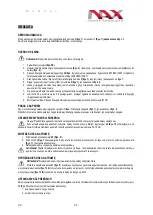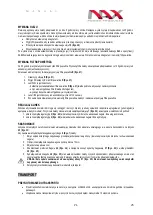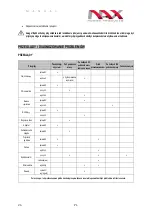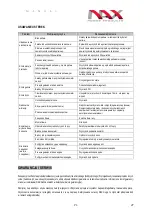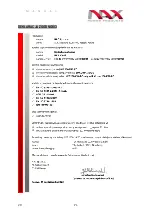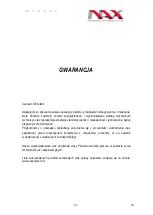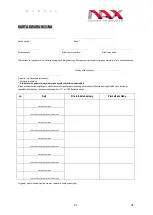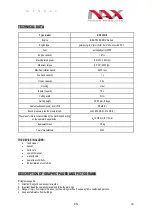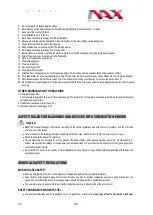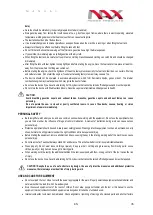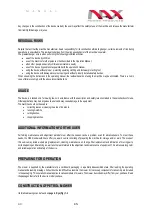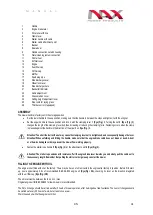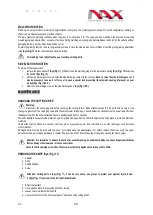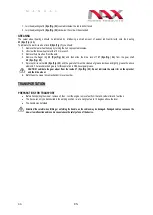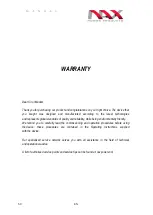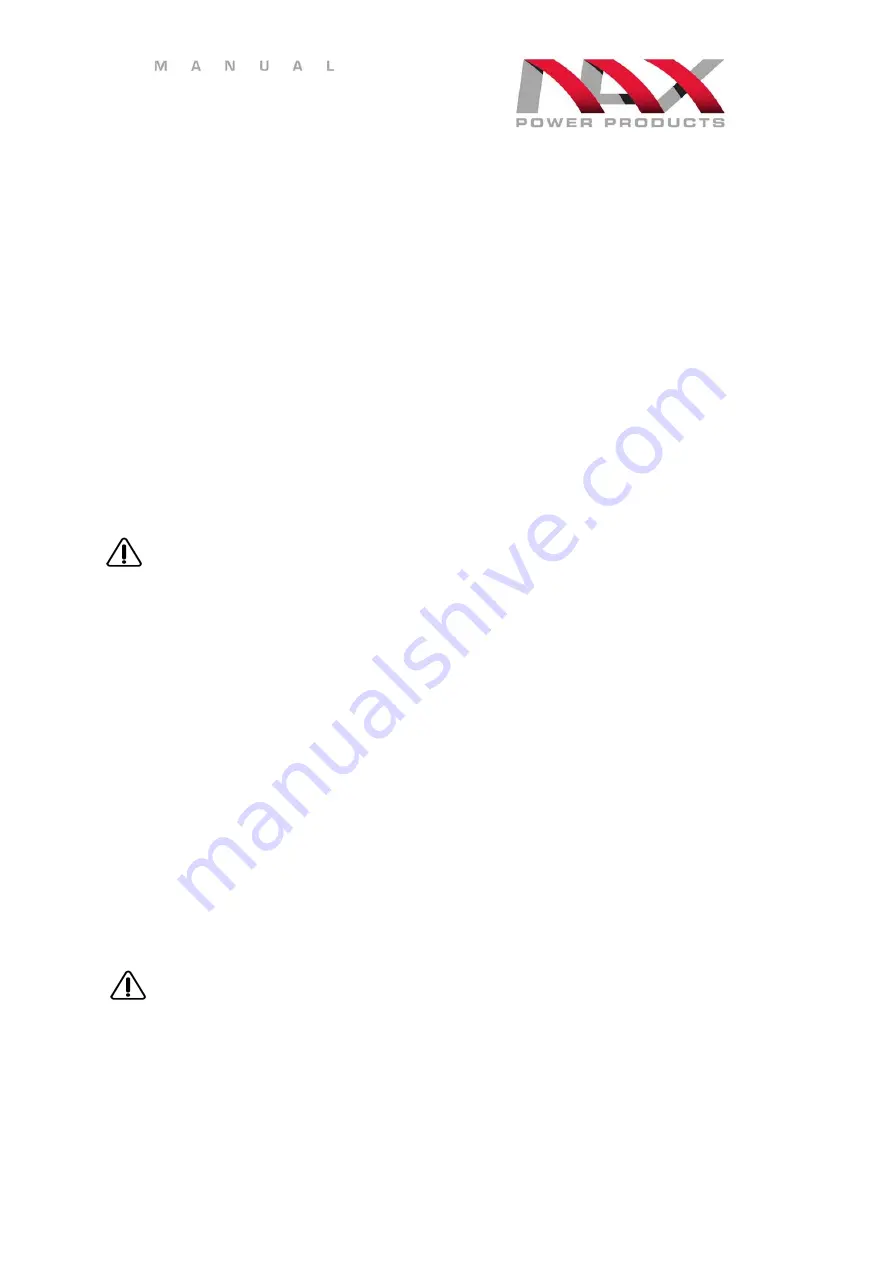
EN
35
data).
Gasoline should be stored only in specially prepared containers (canisters).
Store gasoline away from factors that could cause a fire, e.g. bonfires, open flames, where there is electric sparking, elevated
temperature, welding sparks or other heat sources that can cause fuel to ignite.
The fuel tank should only be filled outdoors.
It is extremely dangerous to smoke cigarettes or use open flames when the machine is running or when filling the fuel tank.
Always turn the engine off and cool before filling the tank with fuel.
Do not fill the tank above the lower edge of the filler neck, gasoline has a high thermal expansion.
If you spill fuel, immediately wipe up spilled gasoline with a dry cloth.
When filling the fuel tank, be careful not to spill fuel on clothing. Gasoline-soaked clothing can catch fire and should be changed
immediately.
After filling the tank with fuel, tighten the cap tightly and before starting the engine, move the fuel canister to a place at least 3 m
away from the place where the filling was carried out.
Before starting the engine, check the tightness of the entire fuel system, especially the fuel tank, fuel lines, connectors, filler cap
and carburetor area. Do not start the engine if you detect a leaking fuel system as it may cause a fire.
The device should not be operated in explosive atmospheres, which form flammable liquids, gases or dust. The internal
combustion engine may create sparks which may ignite the dust or fumes.
Do not use the device if you have trouble turning it off. Any device that cannot be turned off is dangerous and must be repaired.
Do not store the device with filled fuel tank indoors. Gasoline vapors are flammable and dangerous to health.
CAUTION!
Avoid breathing gasoline vapors and exhaust fumes. Gasoline, gasoline vapors and exhaust fumes can cause
poisoning.
Do not operate the saw in closed or poorly ventilated rooms. In case of headache, nausea, hearing or vision
impairment, stop work immediately.
PERSONAL SAFETY
Be foresightful, watch what you do, and use common sense when working with the equipment. Do not use the equipment when
you are tired or under the influence of drugs, alcohol or medication. A moment of inattention during work can cause serious
personal injury.
Protective equipment should be used. Always wear safety glasses. Wearing protective equipment such as a dust mask, non-slip
shoes, helmet or hearing protectors under the right conditions will reduce personal injury.
Before starting the equipment, remove all objects and keys. Leaving the key in the rotating working part of the machine can cause
personal injury.
Do not lean too far. You should always stand firm and balance. This will allow better control in unpredictable situations.
Dress properly. Do not wear loose clothing or jewelry. Keep your hair, clothing and gloves away from moving parts. Loose
clothes, jewelry or long hair can be caught in moving parts.
When working, hold the tool by the additional handles if the tool is equipped with them. Losing control of the tool carries the risk
of injury.
Do not use the device if you have trouble turning it off. Any device that cannot be turned off is dangerous and must be repaired.
CAUTION! Despite the use of a safe structure by design, the use of protective measures and additional protective
measures, there is always a residual risk of injury during work.
USE AND CARE FOR EQUIPMENT
Do not overload the tool. Use a tool with the power appropriate for the work. Properly selected equipment will enable better and
safer work under the load for which it was designed.
Store the unused equipment out of the reach of children. Do not allow people not familiar with the tool or this manual to use the
equipment. Internal combustion tools and equipment are dangerous in the hands of untrained users.
Internal combustion tools must be maintained. Check alignment or jamming of moving parts, cracked parts and all other factors
Summary of Contents for 3001S
Page 1: ...NAX 3001S...
Page 2: ...2 A B C D...
Page 4: ...4 Rys 2 Rys 1...
Page 5: ...5 Rys 3 Rys 4 Rys 5A Rys 5B Rys 6 Rys 7 Rys 8 Rys 9...
Page 6: ...6 Rys 10 Rys 11 Rys 12A Rys 12B Rys 13 Rys 14 Rys 15...
Page 7: ...7 Rys 16A Rys 16B Rys 16C Rys 16D Rys 17 Rys 18 Rys 19A Rys 19B...
Page 8: ...8 Rys 24 Rys 25 Rys 22 Rys 23 Rys 20 Rys 21...
Page 9: ...9 Rys 26...
Page 28: ...28 PL DEKLARACJA ZGODNO CI...
Page 49: ...EN 49 DECLARATION OF CONFORMITY...
Page 72: ...72 DE KONFORMIT TSERKL RUNG...
Page 94: ...94 ES DECLARACI N DE CONFORMIDAD...
Page 116: ...116 FR D CLARATION DE CONFORMIT...
Page 139: ...IT 139 DICHIARAZIONE DI CONFORMIT...
Page 143: ...IT 143...
Page 144: ...144 IT...

